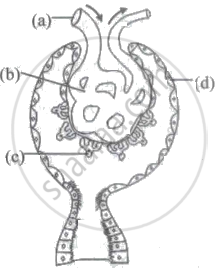Advertisements
Advertisements
प्रश्न
What are the functions of ureter and urethra?
उत्तर
The ureter carries urine from the kidneys to the urinary bladder.
The urethra carries urine from the urinary bladder to the outside of the body.
APPEARS IN
संबंधित प्रश्न
Given below is the figure of certain organs and associated parts in the human body. Study the same and answer the question that follow:
Name the two major steps involved in the formation of the fluid that passes down the part labeled '3'.

What kind of urine (concentration) is produced in the human body?
Mention, if the following statement is True or False. If false rewrite the wrong statement in its correct form:
Ammonia is converted into urea in kidney.
Write the functional activity of the following structure: Adrenal gland
Identify the labels (a, b, c, d) in the given diagram of the Malpighian corpuscle and choose the correct option.

Maximum amount of urea is present in the blood carried by the ____________.
The collecting tubule of the kidney is important as it helps in ______.
Which are the two main organic wastes present in urine?
Match the terms given in Column I with their physiological processes given in Column II and choose the correct answer
| Column I | Column II |
| A. Proximal convoluted tubule | i. Formation of concentrated urine |
| B. Distal convoluted tubule | ii. Filtration of blood |
| C. Henle's loop | iii. Reabsorption of 70 - 80% of electrolytes |
| D. Counter-current mechanism | iv. Ionic balance |
| E. Renal corpuscle | v. Maintenance of concentration gradient in medulla |
Kidneys are vital organs for survival. Several factors like infections, injury or restricted blood flow to kidneys reduce the activity of kidneys. This leads to the accumulation of poisonous wastes in the body, which can even lead to death. In case of kidney failure, an artificial kidney can be used. An artificial kidney is a device to remove waste products from the blood through dialysis.
i. a. Name the artery that brings oxygenated blood to the kidney.
b. Name the cluster of the thin-walled blood capillaries present in the Bowman's capsule.
ii. In the human excretory system, name the organ which stores urine. Is this organ under hormonal control or nervous control?
iii. List two major steps involved in the formation of urine and state in brief their functions.
OR
iii. In which part of the nephron does selective reabsorption take place? List the factors which the amount of water reabsorbed depends on.
